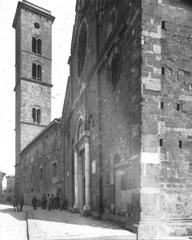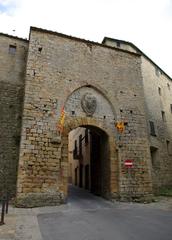Porta Menseri Volterra: Complete Visitor Guide to Tickets, Hours, and History
Date: 14/06/2025
Introduction
Nestled within Volterra’s ancient city walls, Porta Menseri stands as a unique historical gateway, offering a compelling glimpse into the evolution of this Tuscan hill town from its Etruscan roots through Roman adaptation and medieval resilience. While often overshadowed by the city’s more famous entrances like Porta all’Arco, Porta Menseri is a vital part of Volterra’s layered urban history and a tranquil spot to appreciate the region’s strategic architecture and stunning landscapes.
This guide provides a thorough overview of Porta Menseri’s history, architectural features, practical travel information (including visiting hours and ticketing), and tips for integrating this hidden gem into your Volterra itinerary. Whether you’re a history enthusiast or a curious traveler, Porta Menseri enriches your understanding of Volterra’s past and present.
Table of Contents
- Introduction
- Historical Context
- Architectural Features
- Porta Menseri’s Role in Volterra’s Heritage
- Visiting Porta Menseri
- Nearby Attractions and Amenities
- FAQs
- Conclusion
- References
Historical Context
Etruscan Origins
Volterra, known as Velathri in Etruscan times, was a significant city in the Etruscan Dodecapoli. Its massive fortifications, constructed in the 4th century BCE, enclosed an area nearly double that of today’s city, with gates like Porta Menseri serving as both practical entry points and symbols of civic identity (Ancient Origins).
Roman and Medieval Developments
After the Roman conquest in the 3rd century BCE, the city—renamed Volaterrae—saw its defensive structures enhanced with arches and inscriptions reflecting Roman authority. In the turbulent medieval centuries, Volterra’s gates, including Porta Menseri, were repeatedly fortified and repaired to meet shifting defensive needs (Tuscany Now & More). The name “Menseri” likely has local, Latin, or Etruscan roots, underscoring the area’s continuity.
Architectural Features
Porta Menseri is built from large local stone blocks, exemplifying the robust construction techniques of both Etruscan and later Roman military architecture. Its relatively narrow passageway was designed for controlled access and defense. Unlike the ornate Porta all’Arco, Porta Menseri’s design is more austere, possibly featuring modest heraldic or religious symbols that reflect Volterra’s evolving civic and religious affiliations (Wikimedia Commons).
Preservation efforts over the centuries have maintained the essential form of the gate, even as the surrounding city landscape has changed. Today, its integration into the city walls and the dramatic proximity of the Balze cliffs offers visitors both historical perspective and breathtaking views.
Porta Menseri’s Role in Volterra’s Heritage
Porta Menseri is a testament to Volterra’s layered history, symbolizing the city’s transformation from a fortified stronghold to a welcoming destination. The gate is part of a network of surviving city entrances—eleven of which remain today—that were crucial in urban defense and commerce (Casa Volterra). Its preservation is partly due to Volterra’s relative isolation and changing fortunes after the 17th century.
Culturally, Porta Menseri takes on renewed significance during festivals like Volterra AD 1398, when the city’s gates become backdrops for historical reenactments and celebrations (Visit Tuscany). As an access point to quieter neighborhoods and scenic overlooks, it connects modern visitors to both the city’s heritage and its natural beauty.
Visiting Porta Menseri
Location and How to Reach
Porta Menseri is in the Borgo San Giusto district, on Volterra’s western edge. To access it:
- Head west from Volterra’s historic center along Via Patre Eugenia Barsanti.
- Pass Porta San Francesco, continue about 350 meters, then turn left following signs for “Camping” and “Balze.”
- Use the Le Balze parking lot (Via di Mandringa, GPS 43.412172, 10.850483), which is directly across from Camping Le Balze (reise-zikaden.de).
- From the parking area, it’s a short 150-meter walk to Porta Menseri and the nearby Church of San Giusto Nuovo.
Visiting Hours and Tickets
- Hours: Porta Menseri is an open-air, outdoor monument with no set visiting hours—accessible at any time, though daylight visits are recommended for safety and visibility.
- Tickets: No tickets are required; access is free. Some guided tours or special events in Volterra may include the gate as a stop and could require booking (reise-zikaden.de).
Accessibility
- The approach involves uphill walking and uneven cobblestoned paths.
- Porta Menseri is not fully accessible for wheelchairs or those with limited mobility; nearby city-center attractions may offer better accessibility (The World Pursuit).
Parking and Navigation
- Volterra’s historic center is a ZTL (Zona a Traffico Limitato); use designated parking outside the walls, such as Le Balze (livingnomads.com), and walk in.
- Arrive early during peak seasons, as parking can fill quickly.
Safety and Visitor Tips
- Wear sturdy shoes suitable for uneven terrain.
- The area is generally safe, but exercise caution near the Balze cliffs, especially after rain.
- Carry water, sun protection, and consider early morning or late afternoon visits for cooler temperatures and optimal photography (duckexplore.com).
- Respect the site by not climbing on the gate or touching delicate surfaces.
Nearby Attractions and Amenities
- Church of San Giusto Nuovo: 18th-century church above the gate, featuring a baroque façade and terracotta statues.
- Badia Camaldolese Monastery Ruins: Atmospheric ruins near the Balze cliffs.
- Etruscan Rock Tombs (Badia Necropolis): Significant archaeological site just below the church.
- Dining:
- Trattoria Lo Sgherro (Borgo San Giusto 74): Local Tuscan cuisine.
- Trattoria Pizzeria Le Balze (Borgo San Giusto 49): Pizza, calzoni, and homemade desserts.
- Public restrooms are limited—plan to use facilities in dining establishments.
Frequently Asked Questions (FAQ)
What are Porta Menseri’s visiting hours?
Porta Menseri is accessible year-round at all hours, as an open-air historical site.
Is there an entry fee?
No, visiting Porta Menseri is free.
How do I reach Porta Menseri?
Park at Le Balze outside Volterra’s center, then walk about 150 meters following signs toward “Balze” and “Camping.”
Is the site accessible for people with disabilities?
The cobblestoned and uneven terrain around Porta Menseri may present challenges for those with mobility impairments.
Are there guided tours?
Some local walking tours include Porta Menseri; check with the Volterra tourist office or reputable operators, especially during festivals.
Conclusion
Porta Menseri is a captivating testament to Volterra’s millennia-old story—an accessible, free, and tranquil site for those seeking a deeper connection with Tuscany’s ancient past. Its strategic location, preserved architecture, and integration into walking routes and cultural events make it a rewarding destination for history lovers, photographers, and explorers alike. Combine your visit with nearby attractions for a comprehensive Volterra experience.
Ready to plan your visit? Download the Audiala app for walking routes, audio guides, and tips on Volterra’s hidden gems. Explore more about Volterra’s history through our related posts and follow us for the latest travel inspiration.
References
- Ancient Origins - Volterra
- Tuscany Now & More - Volterra Travel Guide
- Wikimedia Commons - Porta Menseri Images
- Casa Volterra - The 11 Gates of Volterra
- reise-zikaden.de - San Giusto and Badia Necropolis
- Visit Tuscany - Things to Do in Volterra
- duckexplore.com - Volterra Travel Guide 2025
- livingnomads.com - Things to Do in Volterra
- Terre di Pisa - Volterra
- The World Pursuit - Italy Travel Tips
- Wikiloc - Di porta in porta walking route
- Italy Guides - Volterra in a Nutshell
- Tuscany Planet - Things to Do in Volterra
- The Geographical Cure - One Day in Volterra
- Wandering Italy - The Gates of Volterra

